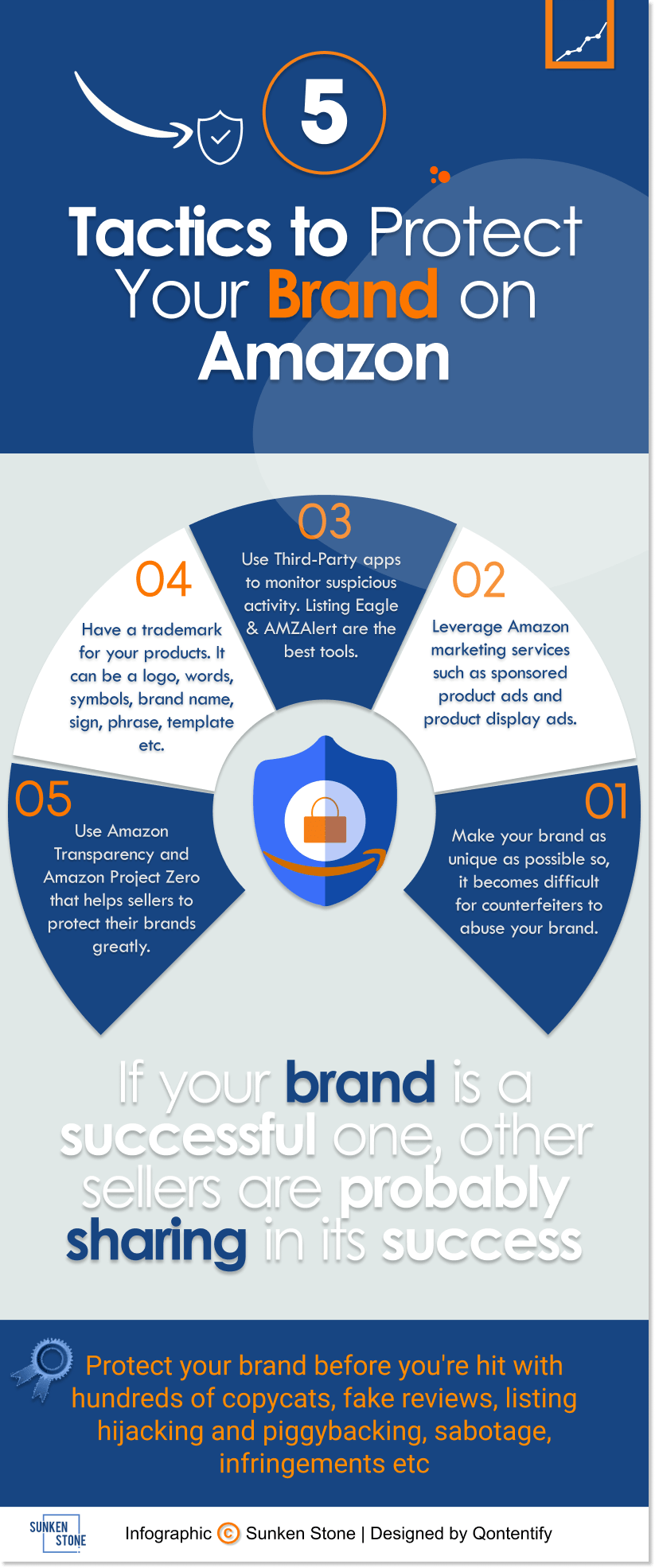
You’ve worked hard to build your brand on Amazon and all of a sudden you’re hit with hundreds of copycats, fake reviews, and other issues that require Amazon brand protection.
But how?
Let’s face it. Much as Amazon is a platform trusted by millions of sellers and shoppers across the world, there are many shady resellers on the marketplace. This post explains several strategies for maximizing your Amazon brand protection efforts this year.
The following are some of the attacks Amazon sellers may face:
Listing Hijacking & Piggybacking
There’s listing hijacking whereby a third-party seller or distributor sells a counterfeit version of the products you’re offering or a similar version of your private level product; thereby taking away the Amazon
Buy Box from your proprietary product.
Another type of attack you may face as an Amazon seller is piggybacking. This occurs when someone copies your product listing and sets up their own. Most piggyback listers sell counterfeit versions of your products and this could ruin your brand’s reputation in a big way.
You’ll end up with negative feedback on your original listing and since the copycats will sell at a lower price, they will steal the buy box from you. Other copycats will copy your product description word-to-word and use your product photos as their own.
Amazon Listing Sabotage
Your competitors may find ways to alter your product listing on Amazon to scare away customers. For instance, they can alter titles to misrepresent your product, add blurry images, misleading information, and switch your products to the wrong categories. These attacks can significantly reduce your sales and sabotage your business.
Most Amazon shoppers look at reviews before making a purchasing decision, so it has become a common practice for miscreants on Amazon to post fake reviews on their competitors’ product listings.
They may use their friends and relatives or create different zombie Amazon buyer accounts and post lots of negative reviews on your listing to scare away customers. Some fraudulent competitors may go as far as buying your products through Amazon and leave one-star reviews.
Unfortunately, it becomes quite difficult to identify such fake reviews because Amazon views them as authentic buyers because they actually bought the product. Apart from posting negative reviews on your product listing, unscrupulous competitors may post glowing reviews that obviously look like spam.
Amazon has over the years put a lot of effort into getting rid of fake reviews. As a seller, you can also take certain measures to protect your brand from fake reviews sponsored by shady competitors. We’ll look at those strategies in another section.
Patent Infringement On Amazon
If your product is patented, some sellers may try to violate your patent in various ways. Amazon does not condone patent infringement, so if you find that a seller is selling your patented product without your permission, you’ll report them to Amazon and the product will be pulled down. You can also send a cease and desist letter to the seller.
Trademark Infringement
A trademark distinguishes the products or services of one seller from another. It can take the form of a name, logo, slogans, and words. Some sellers may copy the logo, brand name, and images of successful brands on Amazon in an attempt to woe buyers.
If you find another seller infringement on your trademark, you can report them to Amazon. It’s advisable to register your trademark so that it can be easy for Amazon to enforce trademark infringement claims.
These are the major types of attacks Amazon sellers need to be aware of to protect their brands.
Amazon Brand Protection: How To Mitigate Risks In 2022
The first thing to understand is that Amazon is “just” a gateway to doing business in the digital landscape (i.e. it doesn’t try to protect your brand in its most basic form).
Although Amazon has a code of conduct for its selling that seeks to protect all legitimate sellers from unscrupulous sellers and arbitragers, miscreants always find their way into the marketplace.
Amazon can take a range of actions against copycats including banning them from the platform but it’s always best to protect your Amazon business from copycats before they bring down your business.
For instance, if a competitor floods your product page with negative reviews, they would have taken away the buy box from you before you realize it. So it’s your responsibility to keep your eyes open and defend your Amazon business from copycats, fake reviews, and other fraudulent practices.
It takes a long time for you to build your Amazon business, but all it takes to ruin your reputation is one counterfeit product of the same name or one listing sabotage.
What Is Amazon Brand Protection Anyway?
Amazon isn’t the only place where your brand is at risk of counterfeits or attacks. Amazon brand protection plays a major role for most online retailers. Basically, brand protection is the act of putting effective measures in place to prevent dishonest sellers from infringing your brand in various ways.
It enables sellers to protect their brands against counterfeiters, copyright infringers, and brand abuse.
Various forms of brand abuse hurt your sales, injure your reputation, cause loss of trust, and costs you a lot of money as you try to fight back against counterfeiters.
That’s why it’s advisable to have a solid strategy in place to protect your brand. Amazon brand protection allows sellers on Amazon to recapture revenue, protect their Buy Box from being taken away by shady sellers, maintain their good reputation, and enjoy direct cost savings.
How To Implement Amazon Brand Protection For Your eCommerce Brand
Fortunately, Amazon offers so-called Brand Registry services allow you to protect your brand within the Amazon ecosystem, but at what cost? Amazon’s brand registry is a program that allows registered brand owners to protect their brands against counterfeiting and various forms of intellectual property violations.
This program comes with tools that enable verified brand owners to prevent third-party sellers from brand abuse. It also offers access to a range of authenticity programs and there’s a dedicated internal team that is ready to provide users with the help they might need.
If your product is not brand registered anyone can update your product listing because you have no control whatsoever.
To qualify for the Brand Registry application, you’ll need to register your trademark and this will cost you between $225 to $400. Though the cost may vary based on a range of factors.
With The Amazon Brand Registry, You Can:
- Report listing hijacking and piggybacking and sabotage
- Report copyright infringement and patent violation
- Prevent authorized changes to your product detail pages
- Submit IP infringement claims
- Search for misuse of your trademarks and report any violations directly to Amazon.
- Report listing issues such as incorrect information on detail pages
Generally, Amazon’s brand registry legitimizes your brand and gives you unique advantages over non-registered brands.
Advantages of Amazon’s brand registry services:
- Gives brand-registered users more control and leverage
- Helps you to protect your brand from brand infringement, counterfeiting, listing hijacking, and other forms of brand violations.
- Helps you to increase your products’ visibility through A+ content and alternative advertising strategies
- Comes with powerful search and report tools that help users to protect their brands against infringement
- Quicker approval of items under your portfolio
The 5 Tactics To Use For Great Amazon Brand Protection
With Brand Registry, protecting your brand on Amazon is easier than it would be to do it on your own.
However, there are 5 tactics that you can implement even without it.
Let’s have a look at the infographic:

Amazon Brand Protection Tactic 1: Make Your Brand As Unique As Possible
When your brand stands out in a unique way, it becomes difficult for counterfeiters to abuse your brand.
The more unique your brand is, the more it will stick out when shady sellers try to copy you.
Examples of renowned brands that have differentiated themselves to a point where counterfeiters can’t copy them include McDonald’s, Pizza Hut, Nike, Coca-cola, Apple, and many more.
The following are the best ways you can differentiate your brand and stand out in the Amazon marketplace:
- Hire an expert to design a logo and template for your brand—This is a vital element of the branding process and it will help you to stand out in a crowded marketplace.
- Find market gaps to fill— Counterfeiting tends to be prevalent in an overcrowded niche. That’s why you need to come up with unique ideas that will address customers’ pain points. When your brand offers better value than what your competitors are offering, it becomes difficult for shady sellers to copy.
- Explain what makes your product better than your competitors’ products—Along with highlighting the selling points of your products, be sure to expose the weaknesses of other brands to gain a competitive edge.
- Put your logo everywhere, including on your listing, images, packaging, and the actual product. This prevents copycats from copying your work.

Tactic 2: Leverage Amazon Marketing Services
Using Amazon’s advertising options such as sponsored product ads and product display ads can protect your brand from unscrupulous third-party sellers. Using Amazon marketing services will ensure the search results page for your branded search only feature your products.
This prevents third-party sellers and competitors from counterfeiting your products, sabotaging your business, and stealing sales away from you.
Tactic 3: Use Third-Party Apps To Monitor Suspicious Activity
Amazon brand protection entails continuously monitoring all activities relating to your Amazon business. Fraudulent sellers on Amazon tend to be smart most of the time and they know how to mask their identities and hide their trails.
You’ll need to use more advanced tools to protect your brand. There are tools that are designed to detect suspicious activity such as changing your description or images.
Listing Eagle and AMZAlert are the best tools you can leverage to protect your brand from hijackers. Listing Eagle promises 24/7 real-time alerts and allows you to send cease and desist notifications immediately.
AMZAlert provides comprehensive listing security.
This tool will send you alerts whenever changes are made to your product listing. It also enables you to monitor reviews to prevent fake reviews.

Tactic 4: Have A Trademark For Your Products
A trademark is something that legally differentiates your products from other products in a marketplace. It can be a logo, words, symbols, brand name, sign, phrase, template, and many more. Registering your trademark will help to protect your brand from copycats as it distinguishes the source of your products.
Apart from differentiating the products on your portfolio, a trademark allows you to enroll in Amazon’s brand registry. Owning your trademark gives you legal rights to challenge anyone copying your brand and profiting off your brand. A trademark should be renewed every 10 years.
Tactic 5: Use Amazon Transparency And Amazon Project Zero
Project Zero is a reliable Amazon brand protection tool that helps sellers to protect their brands from hijackers and counterfeiters. This tool combines Amazon’s advanced technology and innovation with machine learning abilities to scan the Amazon marketplace for potential counterfeiters and remove them.
With this tool, you can remove counterfeits without having to contact Amazon. Project Zero also produces a unique serial code for each product; hence allowing sellers to differentiate their products. However, you must enroll in Amazon Brand Registry services to be able to use this tool for Amazon brand protection.
Amazon Transparency gives you unique barcodes that authenticate your products. This tool helps Amazon sellers to prevent counterfeits from reaching customers. You don’t need to enroll for Brand Registry services to use Amazon Transparency, though you must register your trademark to qualify to use the tool. It also comes with an app that you can use to check for counterfeiters.
It’s easy to fall trap of platform mentality on Amazon (i.e. they should handle everything) but, in reality, many Amazon brand protection tactics still rely on your efforts. Be sure to keep all your eyes open and keep updated on the latest developments regarding Amazon brand protection. If you have a budget for brand protection, you can consider hiring experts to help you.
Protecting Your Brand On Amazon In 2022
Once you have a good Amazon business going, there’s a ton that goes into Amazon brand protection. And it’s not that easy to manage everything on your own! You can consider hiring a professional Amazon marketing agency like Emplicit to help you protect your brand.

